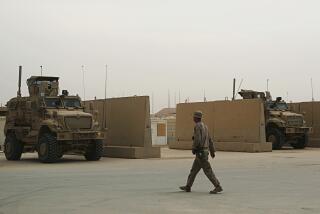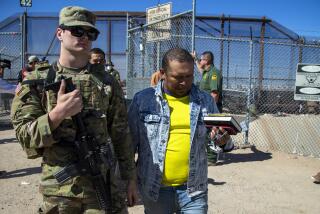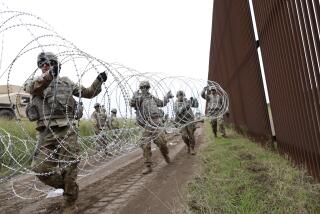U.S. Conditions for Bosnia Troops Include Escape Clauses
WASHINGTON — The Clinton Administration on Tuesday proposed a list of 12 conditions to be satisfied before the United States would deploy 25,000 troops to Bosnia-Herzegovina for peacekeeping if the war there ended.
Several of the conditions would allow U.S. troops to back out if conditions became dangerous.
Asst. Secretary of State Stephen Oxman told the Senate Foreign Relations Committee that the United States would send substantial forces to Bosnia only after “limited advance NATO deployments” to determine whether a peace agreement was holding.
Even after that, he said, deployment would occur only gradually to permit the United States to test the situation further. “If it looks like a quagmire, that will give us the opportunity to cut our losses,” another official said.
Senators seemed unimpressed and focused on complaints that the Administration has failed to provide a convincing rationale for sending U.S. troops on peacekeeping missions to either Bosnia or Somalia.
“The question . . . is, quite simply, ‘Is there some stake that is worth sending American soldiers into harm’s way?’ ” said Sen. John Kerry (D-Mass.).
Oxman listed the following Administration conditions:
1) “An agreement must be reached and accepted by all parties.
2) “It must be viable and contain adequate implementation provisions and terms that all parties respect.
3) “To demonstrate their willingness to honor the agreement, the parties must make a joint formal request that NATO, pursuant to U.N. authorization, help to implement and enforce it.
4) “Next, after an agreement is signed, there must be prompt action by the parties to make substantial changes in their behavior that indicate their seriousness, including a substantial diminution of hostilities.
5) “Limited advance NATO deployments after the agreement takes effect will help it get off the ground by demonstrating our seriousness. The phasing of subsequent deployments on a schedule determined by practical considerations will provide us the opportunity to assess the parties’ intentions.
6) “NATO must exercise command and control over all military forces, including those from non-NATO states.
7) “NATO will develop the rules of engagement, which will permit military commanders to use all necessary force for self-defense and to carry out their mission.
8) “Further, the operation must be under the political authority of the United Nations, which must ask NATO to assume responsibility for all military aspects of implementation and accept the concept of operations and rules of engagement developed by NATO. NATO commanders will work in close coordination with U.N. civilian authorities, but NATO commanders will take their orders from the North Atlantic Council (NATO’s political leaders) via the NATO chain of command, not from U.N. civilian officials.
9) “Further, other contributors must provide more than half of the total force.
10) “Funding arrangements acceptable to the U.S. must be agreed upon.
11) “Finally, there must be a clear time limit to NATO’s responsibility and an understanding that at the end of that time period, responsibility for the operation will revert to the U.N.
12) “In addition, as the President has said, we will continue to consult with the Congress, as we have to date, and we will not commit American troops to the implementation operation without congressional support.”
More to Read
Get the L.A. Times Politics newsletter
Deeply reported insights into legislation, politics and policy from Sacramento, Washington and beyond. In your inbox three times per week.
You may occasionally receive promotional content from the Los Angeles Times.











